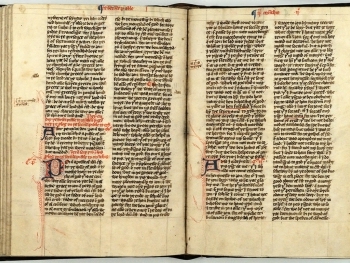The New Revised Standard Version (NRSV) and the New Revised Standard Version Anglican (NRSVA) are both translations of the Bible that stem from the same base text but cater to different denominational traditions. While the NRSV is widely used across various Christian denominations, the NRSVA is tailored specifically for Anglican use, reflecting the theological and liturgical nuances of the Anglican tradition. This post explores the specific differences between the NRSV and the NRSVA, and compares the NRSVA to other British English Bible translations.
Specific Differences Between the NRSV and NRSVA
1. Canonical Differences:
- NRSV: The NRSV is a broadly ecumenical translation used across many Christian denominations, including Roman Catholic, Orthodox, and Protestant communities. It includes the Old Testament, New Testament, and Deuterocanonical books (Apocrypha), which are accepted by the Catholic Church but not included in the Protestant canon.
- NRSVA: The NRSVA, as an Anglican adaptation of the NRSV, aligns with the Anglican tradition's treatment of the Apocrypha. In the NRSVA, the Deuterocanonical books are treated as Apocryphal and are placed in a separate section rather than being integrated into the main Old Testament text. This reflects the Anglican perspective, which often regards these books as valuable for reading but not on par with canonical Scripture.
2. Textual and Translation Notes:
- NRSV: The NRSV features extensive textual notes and annotations that provide historical, linguistic, and theological context for the text. These notes aim to serve a wide audience, including scholars, clergy, and lay readers, and cover a broad spectrum of Christian traditions.
- NRSVA: The NRSVA includes notes and annotations that are particularly tailored for Anglican readers. While maintaining much of the NRSV’s scholarly approach, the NRSVA’s notes and introductions often reflect Anglican interpretations and concerns, particularly in relation to liturgy and church practice.
3. Liturgical Use and Emphasis:
- NRSV: As a translation designed for a broad Christian audience, the NRSV is used in various liturgical settings across denominations. Its language and style aim for inclusivity and accessibility, catering to a wide range of readers and liturgical contexts.
- NRSVA: The NRSVA is specifically crafted to meet the needs of Anglican liturgy and worship. Its translation choices and annotations are geared towards Anglican practices, reflecting the theological emphases and liturgical norms of the Anglican Communion.
4. Language and Style:
- NRSV: The NRSV uses contemporary, inclusive language that aims to be both readable and respectful of traditional biblical language. It balances accuracy with readability, making it suitable for both academic and devotional use.
- NRSVA: While the NRSVA retains much of the NRSV's style, it may include specific language choices and phrases that resonate more closely with Anglican worship and doctrine. This can include variations in terminology and phrasing that align with Anglican theological and liturgical preferences.
Comparison of the NRSVA to Other British English Bible Translations
1. The Authorized Version (King James Version - KJV):
- Historical Context: The Authorized Version, also known as the King James Version, was first published in 1611 and remains a significant translation in the English-speaking world, particularly within Anglican traditions.
- Language and Style: The KJV is known for its formal, majestic language and its literary influence. It uses Early Modern English, which can be challenging for contemporary readers but is celebrated for its rhythmic and poetic qualities.
- Comparison with NRSVA: The NRSVA, with its contemporary and inclusive language, contrasts sharply with the KJV’s traditional and formal style. While the KJV holds a place of historical and literary significance, the NRSVA aims to be more accessible and relevant to modern readers, reflecting current scholarship and inclusive language principles.
2. The Revised Standard Version (RSV):
- Historical Context: The RSV, published in the mid-20th century, was an attempt to provide a modern update to the King James Version while maintaining a formal equivalence approach to translation.
- Language and Style: The RSV uses formal but more contemporary English than the KJV. It is respected for its accuracy and literary quality but does not employ the inclusive language found in the NRSV and NRSVA.
- Comparison with NRSVA: The NRSVA builds on the RSV but incorporates more recent scholarship and inclusive language. While the RSV was influential in its own right, the NRSVA reflects a more modern approach to translation, addressing contemporary issues of language and inclusivity.
3. The Jerusalem Bible (JB):
- Historical Context: The Jerusalem Bible, first published in English in 1966, is a Catholic translation known for its scholarly approach and use of inclusive language. It is based on the French Bible de Jérusalem.
- Language and Style: The JB is noted for its readability and extensive footnotes, which provide theological and historical context. It emphasizes literary quality and scholarly depth.
- Comparison with NRSVA: The NRSVA differs from the JB in its Anglican focus and approach to the Apocrypha. While both translations aim for readability and scholarly integrity, the NRSVA aligns with Anglican traditions and practices, whereas the JB is more closely associated with Catholic scholarship and interpretation.
4. The New Jerusalem Bible (NJB):
- Historical Context: The New Jerusalem Bible, an update of the Jerusalem Bible, was published in 1985 and incorporates more recent biblical scholarship and a modern English style.
- Language and Style: The NJB is known for its accessible language and extensive annotations. It builds on the Jerusalem Bible’s strengths with updated scholarship and language.
- Comparison with NRSVA: The NRSVA and NJB both aim for readability and modern scholarship but differ in their denominational focuses. The NRSVA reflects Anglican traditions and perspectives, while the NJB is designed for a broader Catholic audience and includes different theological emphases and interpretations.
5. The Good News Translation (GNT):
- Historical Context: The GNT, known in the UK as the Good News Bible, is a translation that aims for simplicity and clarity. It was first published in the 1960s and is widely used in various Christian contexts.
- Language and Style: The GNT uses very accessible, contemporary English and is designed for easy reading and understanding.
- Comparison with NRSVA: The GNT's simplicity and readability contrast with the NRSVA’s more formal and scholarly approach. While the GNT is intended for a broad audience with minimal theological jargon, the NRSVA includes theological and liturgical notes that reflect Anglican perspectives.
The New Revised Standard Version Anglican (NRSVA) and the New Revised Standard Version (NRSV) share a common textual base but differ in their canonical treatment, theological notes, and liturgical focus. The NRSVA caters specifically to Anglican readers, reflecting their traditions and practices, while the NRSV is designed for a broader ecumenical audience.
When compared to other British English Bible translations, such as the King James Version, the Revised Standard Version, the Jerusalem Bible, the New Jerusalem Bible, and the Good News Translation, the NRSVA stands out for its Anglican focus and modern translation approach. Each of these translations has its unique characteristics, reflecting different historical contexts, theological perspectives, and linguistic styles.
The NRSVA contributes to the landscape of English Bible translations by offering a version that balances contemporary readability with Anglican theological and liturgical insights, providing a valuable resource for Anglican worship and study.
Revised Standard Version Catholic Edition Revised Standard Version King James Version comparison New Revised Standard Version Catholic Edition Jerusalem Bible translation New Jerusalem Bible Catholic and Anglican Bible translations NRSV vs NRSVA New Revised Standard Version Anglican British English Bible translations Canonical differences NRSV NRSVA Anglican Bible translation Jerusalem Bible Good News Translation








